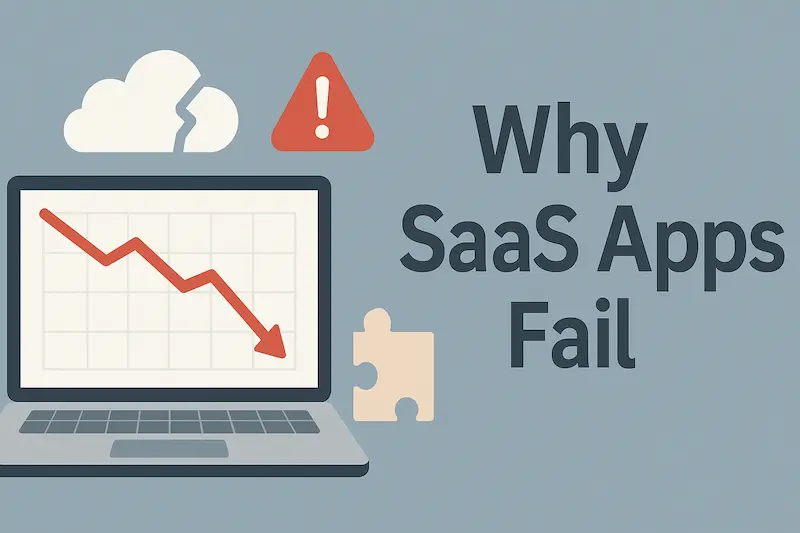Why 90% of SaaS Startups Fail (And How Yours Can Be Different)
The brutal truth about SaaS failures – and the opportunities hiding in plain sight

Here's a sobering fact: 90% of SaaS startups fail. If that doesn't make you pause, consider this – only 0.4% of SaaS businesses ever reach $10 million in annual recurring revenue.
But before you close your laptop and abandon your SaaS dreams, know this: the companies that do succeed often solve the exact problems that kill their competitors. The failure rate isn't random – it follows predictable patterns you can avoid.
The Real Reasons Why SaaS Startups Fail
1. No Market Need (42% of All Failures)
The biggest killer isn't technical debt or funding issues. 42% of SaaS startups fail because they're not solving any existing problem. They build solutions looking for problems rather than solving actual pain points.
The fix? Talk to potential customers before you write a single line of code. Validate the problem exists and people are willing to pay to solve it.
2. Poor User Onboarding Destroys Growth
Here's where most SaaS companies shoot themselves in the foot: 74% of potential customers will switch to other solutions if the onboarding process is complicated.
Think about it – you've spent months building your product and marketing it. A prospect signs up, excited to try your solution. Then they hit a confusing onboarding flow and... they're gone.
The opportunity is massive: 63% of customers think user onboarding is key in deciding whether to subscribe to a product. Get this right, and you've solved a problem that kills most of your competition.
3. Running Out of Cash (29% of Failures)
Money problems kill 29% of SaaS startups. But it's rarely about not raising enough funding – it's about burning through cash without achieving product-market fit.
Smart SaaS companies focus on extending runway and reaching profitability faster through better customer success and upselling strategies.
4. Ignoring Customer Success
Many founders think their job is done once someone signs up. Wrong. Poor customer support diminishes user satisfaction and leads to higher churn rates.
The companies that survive prioritize customer success from day one. They understand that keeping existing customers is cheaper than acquiring new ones.
The Hidden Opportunities in SaaS Failures
Here's what's exciting: every major failure point represents a massive opportunity for SaaS companies that get it right.
The Onboarding Gold Mine
By 2025, the onboarding software market is expected to reach $1.35 billion. Why? Because smart companies realize that an effective onboarding process boosts new customer retention by 82%.
While your competitors lose customers in their first week, you can win by making those crucial first interactions seamless and valuable.
The Upselling Advantage
Most SaaS companies see conversion rates between 3-10% when onboarding new users to free trials. But here's the kicker: when freemium users are encouraged to upgrade to paid plans, conversion rates jump to 8-20%.
Customer success teams are increasingly taking ownership of upselling because they know customers best and can make recommendations at the right time.
The SEO Opportunity
While everyone chases expensive paid ads, smart SaaS companies build organic growth engines. B2B SaaS companies see a 702% ROI from SEO, and companies with consistent blogs attract 97% more backlinks than those without.
What Successful SaaS Companies Do Differently
They focus on solving real problems. Instead of building cool technology, they obsess over customer pain points and measure success by problem resolution, not feature counts.
They perfect their onboarding. Successful SaaS companies use progress bars (76% of companies), welcome screens (90% of companies), and micro-surveys to guide new users to their "aha moment" faster.
They treat customer success as a growth engine. They don't just provide support – they proactively help customers succeed, leading to natural upselling opportunities and lower churn.
They measure what matters. Beyond vanity metrics, they track customer lifetime value, churn rates, time to value, and feature adoption rates.
Your Path Forward
Yes, the statistics are daunting. 90% failure rates aren't encouraging. But remember – every successful SaaS company started with the same odds.
The difference? They avoided the common pitfalls that kill their competitors:
- They validated real market need before building
- They invested in seamless user onboarding
- They built customer success into their DNA
- They focused on retention, not just acquisition
- They measured and optimized relentlessly
The SaaS market reached $317.55 billion in 2024 and shows no signs of slowing down. There's room for solutions that genuinely solve problems and deliver value.
Your SaaS doesn't have to be part of the 90% that fail. Learn from the mistakes of others, focus on real customer problems, and build systems that help users succeed.
The companies thriving in 2024 aren't necessarily the ones with the most funding or the flashiest features. They're the ones that make their customers' lives genuinely better – starting from that very first interaction.
Don't give up. Instead, get serious about solving real problems, perfecting your onboarding, and helping your customers succeed. That's where the real opportunity lies.